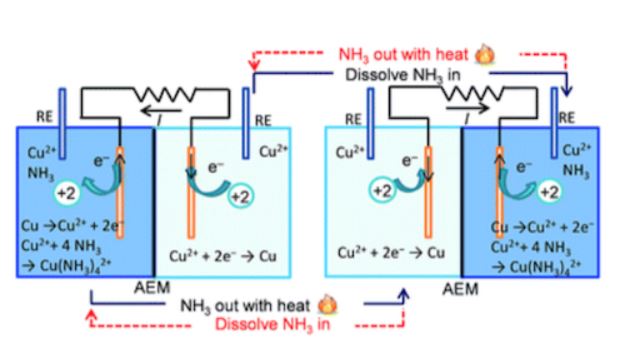Thermally regenerative ammonia batteries can produce electricity on demand from low-grade waste heat. A new process for creating these batteries improves their stability and affordability and may help address the country’s growing grid-scale energy storage problem, according to a team led by Penn State researchers.
“We can use ammonia as an energy carrier to harness waste heat and recharge some battery chemistries,” said Derek Hall, assistant professor of energy engineering. “But previous battery chemistries used metallic zinc or copper electrodes, which had major setbacks in terms of electrode stability. What we did was replace these deposition-based reactions with a novel copper complex chemistry to solve a lot of the major problems facing previous researchers.”
Low-grade waste heat is a significant source of unused energy in the U.S. and around the world, with 60 terawatt-hours of energy discarded into the environment each year by power plants and industry, according to recent studies. Technologies exist that can turn this low-grade waste heat into energy, including thermo-electrochemical cells (TECs), thermally regenerative electrochemical cycles (TRECs), and thermally regenerative ammonia batteries (TRABs); however, there are still a lot of limitations to these battery configurations.
Solid-state TECs are simpler to operate than electrochemical systems but exhibit exceptionally low power densities and lack the ability to store energy. TECs and TRECs have higher thermal efficiencies but still suffer from low power densities, limiting their viability. Of them, TRABs have the largest power densities with energy efficiencies that are competitive with the other low-grade heat technologies but have relied on either cost-prohibitive precious metals like silver or used metal electrodes that degraded quickly, the scientists said.
The Penn State researchers wanted to test all-aqueous copper complexes in TRABs with the hopes that they may improve both battery performance and durability.
“The sourcing and manufacturing of copper are a lot easier compared to other rare elements and critical minerals used in batteries,” Hall said. “If developed, battery chemistries like these can help address our growing grid-scale energy storage problem by harnessing these massive unused waste heat sources.”
Given that all-aqueous copper reactions have never been used in a thermally regenerative ammonia battery before, Hall said the first step was to see if this chemistry would work.
TRABs operate similarly to other hybrid and conventional flow batteries. Battery electrolytes are contained in storage tanks, which are pumped into an electrochemical reactor to produce or store electricity. The size of the reactor directly correlates to the power capacity and tank size correlates to the energy capacity. Most TRABs are hybrid flow battery concepts as they operate using redox reactions that deposit and deplete metals at the electrodes. Unlike other flow batteries, however, TRABs can recharge using low-grade waste heat through an ammonia separation process.
The researchers investigated the limitations of power and energy density and how they are impacted by the electrolyte composition and discharge currents through a series of single-cell tests. By increasing the ammonia concentration, the power density of the battery increased, but the energy density decreased. Increasing discharge current densities increased the average power density during discharge without substantial losses in energy density. Increasing the copper concentration increased both energy density and energy efficiency but did not greatly impact the power density. Depending on the electrolyte composition, the battery produced power density up to 30 milliwatts per square centimeter and energy densities up to 2 watt-hours per liter. These results represent some of the highest performances ever achieved for membrane-based low-grade waste heat to the electricity system.
“What these battery addresses are a technical gap in our energy utilization process,” Hall said. “Only a fraction of the incoming heat we use for fossil fuels gets turned into useful energy. More than 50% is wasted in some cases, so being able to have something like this that can utilize that waste stream and create more power, provides additional value to these precious resources. It is good for the environment by making us more energy efficient.”
The researchers’ next steps are to further optimize the design itself and to consider how this technology can be implemented in the field from both system design and economic perspectives. They want to explore how it would integrate into a thermal energy system, and how big of a physical footprint it would need to produce usable amounts of power and energy.
“The global energy transition is going to happen in myriad ways because decarbonization needs to occur in many different sectors,” said Nicholas Cross, a doctoral candidate in chemical engineering at Penn State and lead author on the project. “This technology could push forward that transition of how and where power and energy are produced by coupling new systems into already existing infrastructure.”







